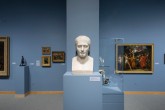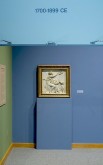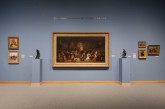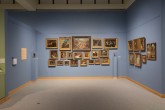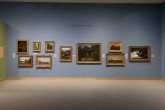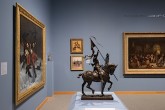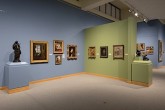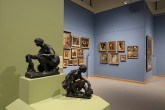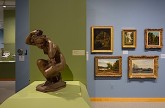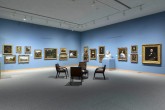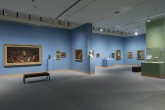The browser will either open the file, download it, or display a dialog.
Reinstallation of the Nineteenth-Century Gallery
Snite Museum of Art, University of Notre Dame, South Bend, Indiana
Fall 2013
A major project on Cheryl Snay’s to-do list, when she joined the Snite Museum of Art as curator of European art in 2010, was the re-installation of the nineteenth-century gallery. As curator of an art museum at a university with a strong commitment to sharing its resources with its local community, Snay was mindful of both the academic and local communities. For this reason, the preparatory roundtable discussions she held in the fall of 2012 included students, faculty from the University of Notre Dame as well as local colleges and universities, members of the Nanovic Institute for European Studies at Notre Dame, the museum’s curators of education, docents and the Snite’s Friends organization. As a relative newcomer to the Snite Museum’s community, Snay wanted to assess visitors’ expectations and planned use of the collection as a teaching and learning tool, as well as a venue for casual visits and enjoyment.
The outcome of these preparations, unveiled in the fall of 2013, reveals what a difference a thoughtful curatorial hand can make in the presentation of a collection. By broadening connections and introducing multi-layered resources, the new installation provides a rewarding experience for the fifteen-minute visitor as well as for the members of the academic community. Snay explains that the “thematic focus [was] motivated by politics: the politics of messaging (narrative impulse); the politics of identity (i.e., portraits); the politics of controlling natural resources (landscapes); the politics of art (the oil sketch section); the art of politics (the war and revolution section).”[1] This thematic arrangement of the paintings and sculptures reflects the change in the hierarchy of genres that occurred during the course of the nineteenth century, prior to the advent of Impressionism. This is prompted in part by the strength of the collection in works that stem primarily from the academic tradition or were produced by lesser-known artists who are now receiving more critical and scholarly attention. These works reveal a rich network of artistic production that reflected the turbulent decades of French history, primarily between 1789 and 1914. As Snay states, “[m]y approach tends to be a bit subversive. I don't think I gave people what they have come to expect from nineteenth-century galleries, generally replete with big name Impressionists and the story of the inevitable march towards modernism.”[2] Indeed, looking for blockbuster candidates will leave the visitor disappointed, but in its newly rehung second-floor gallery, this collection invites examination and study.[3] All the works included here are oil paintings or sketches and sculptures; the small works on paper gallery, located in a main floor gallery, provides more suitable lighting for rotating exhibitions of prints, drawings, and photographs. To coincide with the debut of the reinstallation, Snay organized the exhibition The Academy Exposed: French Figure Studies from the Permanent Collection, intending to extend the examination of academic principles introduced in the second floor gallery.
Two different paths lead to the nineteenth-century collection: the first is a progression from the eighteenth-century gallery, through a wide bay, where a marble, over-life-size bust of Napoleon (ca. 1804) by Antoine-Denis Chaudet marks the transition between the two spaces (fig. 1). The second path enters the gallery at its southeast corner where the viewer is greeted by Bertel Thorvaldsen’s marble relief of a Shepherdess with a Nest of Amorini (1831) (fig. 2). Entering through the bay between the eighteenth- and nineteenth-century galleries, the sequence of thematic groupings runs from “Picturing Politics in 19th-Century France” on the west wall (fig. 3), a “salon hang” of oil sketches on the south wall (fig. 4), separated by a short, perpendicular wall from a section titled “The Narrative Impulse”, leading to the other entrance to the gallery on its southeast corner (fig. 5). The east wall, dedicated to portraits, is titled “Private Lives, Public Display,” (fig. 6) and at a right angle from these portraits, the north wall is dedicated to landscapes or “Nature’s Chronicle” (fig. 7). Each section is clearly marked in black letters running above the paintings.
The first two sections focus attention on a large canvas surrounded by smaller works. Sculptures either frame specific paintings or accentuate the divisions between sections. “Picturing Politics in 19th-Century France” features Charles Louis Lucien Muller’s The Roll Call of the Last Victims of the Reign of Terror (ca. 1860) at the center, flanked by two small bronzes, Honoré Daumier’s Ratapoil (designed 1850–51; cast ca. 1925) and a small cast of Pierre de Weissant, one of Auguste Rodin’s Burghers of Calais (1884). Seven paintings and two sculptures of Joan of Arc by Marie d’Orléans and Emmanuel Frémiet complete this section illustrating the intersection of art and politics (fig. 8). In addition to the Daumier and Rodin bronzes, this section includes The Crows by Wilfrid Constant Beauquesne (1887), Edward Gabé’s The Proletariat Seizing the French Throne (1848), Muller’s Roll Call and the bust of Napoleon; together, these works introduce students to the long nineteenth century’s historical milestones in France, the continued significance of history painting, and political satire or caricature. Not only does it set the stage for the other sections, but paintings such as The Crows invite parallels with such textbook staples as Théodore Géricault’s Charging Chasseur (1812) and Wounded Cuirassier (1814).
The “Narrative Impulse” section focuses on the German painter Edouard Steinbrück’s Adoration of the Magi (1838), flanked by a Madonna by Gustave Doré (ca. 1880) holding the Christ child with arms outstretched as if on the cross. In addition to documenting a continuation of a religious art tradition, the controlled use of color and light in Steinbrück’s Adoration invites consideration of color theory and its evolution during the nineteenth century. On the left of this central pair, the Thorvaldsen relief at the second gallery entrance anchors the exploration of historical and allegorical themes with neoclassical origins, evoking Joseph-Marie Vien’s Seller of Cupids (1763). On the right and left of the Adoration, single or double hung canvases frame this altar-like painting including Horace Vernet’s Pope Pius VIII Carried into St. Peter’s on the Sedia Gestoria (ca. 1830) and L’Inspiration (Le Violoniste, ca. 1852) by Pierre Puvis de Chavannes. On a short partition adjacent to this allegory three canvases by Léon-Augustin L’hermitte, Théodule Ribot and Jean-Louis Forain reflect the greater emphasis on genre painting in the later decades of the century (fig. 9). Forain’s Woman in an Interior (ca. 1895) especially evokes similar interiors with figures by Edgar Degas. At the end of the partition, two small bronze sculptures by Pierre-Auguste Renoir with Ricardo Guinó i Boix, The Small Washerwoman (Water), and The Small Blacksmith (Fire), both cast in 1916, complement the genre holdings on the adjacent wall with works that provide an allegorical dimension to depictions of figures involved in working class activities (fig. 10).
Between these history and narrative sections, a “salon hung” alcove of oil sketches–without labels–includes works by artists such as Horace Vernet, Alfred Dehodencq, Jean-Baptiste Carpeaux, Narcisse Virgile Diaz de la Peña, Jean-Léon Gérôme and Hippolyte Jean Flandrin, as well as two small sculptures (in vitrines) by Aimé-Jules Dalou and Jean-Jacques Feuchère (fig. 11). The theme here shifts from iconography to academic practice. The various forms of oil sketches from croquis to pochade are explained for the viewer in a glossary and color-illustrated key to the sketches that is readily available in the gallery.[4] Looking at the works with the assistance of this printed guide, the viewer can focus on the nature of the medium and identify firsthand the function of the sketch in the creative process, or find the label information. Students using the inviting color guide may not agree on which technique to assign a particular work, but they will look and articulate what they see, an exercise they would be less likely to perform with conventionally hung and labeled works. Beyond encouraging this interaction with the works, this teacher will highlight two works for these students: Alfred Dehodencq’s Study for King Boabdil’s Farewell to Granada (1869) and Hippolyte Jean Flandrin’s Studies for the Chapel of Saint John the Evangelist, Church of Saint-Séverin, Paris (1839–40). Dehodencq evokes Delacroix both in subject matter and use of color, while Flandrin’s sketches for murals in a significant Paris Gothic church introduce the topics of architectural decoration and historic preservation, both hotly debated in nineteenth-century France.
The sections on portraiture (“Private Lives, Public Display”) and on landscape (“Nature’s Chronicle”) both alter the pattern of a central painting bookended by smaller works. In the portrait section, pride of place is given to David d’Angers’ over-life-size plaster bust of Jean-Baptiste Lechevalier (1839) and the recently cleaned Princess of Marie de Sayn-Wittgenstein (1855) by Ary Scheffer. Surrounding this central group are two double-hung pairs of small portraits by Théodule-Augustin Ribot and Eugène Carrière on the left, and Adolphe William Bouguereau and Alfred Dehodencq on the right. From intimate to formal and from sketch to finished portrait, these two pairs invite reflection and focused discussion with students on the nature, significance, and evolution of nineteenth-century portraiture, themes echoed in the larger portraits by Thomas Couture, Charles Louis Lucien Muller, and Jean-Paul Flandrin that complete this wall on the far left and right.
The landscape section also alternates double and single hanging, with works by Constant Troyon, Jean-Baptiste Camille Corot, and Gustave Courbet on the left of Narcisse Virgile Diaz de la Peña’s imposing Stag Hunt (1846). Troyon’s approach in View of the Park at Saint-Cloud (1851) is representative of the style of landscape painting before the Barbizon school, while Corot and Courbet exemplify the looser handling that would characterize later decades. On the right end of the wall, Charles François Daubigny’s La Moisson (ca. 1840) is hung below Constantin Meunier’s Landscape with Factory (1886) next to the larger Jehan-Georges Vibert’s Figures on Rocks at the Edge of the Sea (1867), encapsulating a nineteenth-century evolution from an agricultural to an industrial society that supported the development of tourism for the prosperous bourgeoisie. From stylistic evolution to social history, this wall provides material for discussions that deepen and complicate the trajectory of landscape laid out by textbooks or classroom lectures.
On a small pedestal, a terra cotta sculpture of Flora Crouching (1874) by Jean-Baptiste Carpeaux leads around a small partition to the anonymous French Hadleigh Castle, in Imitation of John Constable (after 1832) displayed on the left side of the bay to the eighteenth-century gallery, facing the bust of Napoleon (figs. 12, 13). For this painting, as well as for Muller’s Roll Call, digital information, provided in the gallery on iPads, constitutes a rich resource on the history, iconography and context of the works that enables viewers to pursue their own investigation about the artist, people, or related paintings, according to individual curiosity and interest. The digital didactics developed for Hadleigh Castle lead visitors through the process of reattribution in an effort to demystify the curatorial enterprise. Hopefully, such “Snite Interactive” digital guides will be developed for other works in the future, possibly inviting student collaboration.
Innovative digital documentation also includes Quick Response (QR) codes on some labels that provide access to primary sources related to the works on display. The QR code on the label for The Portrait of Lechevalier by David d’Angers, for example, takes visitors to a contemporary English translation of the archaeologist’s description of Troy. Other resources for visitors include the above-mentioned glossary and key to the sketches, and an Illustrated Timeline: The Long 19th Century, both with color graphics matching the gallery wall color. Didactic panels reflecting current scholarship introduce most sections. Labels, except in the sketch alcove, range from basic identification to longer didactics, and for works from the Butkin collection, reference to the catalog that is available for consultation on a nearby table. The table also holds a paperback of Emile Zola’s The Masterpiece and a copy of the museum’s catalog for visitors to peruse.[5] It is part of a simple, elegant, and lithe furniture arrangement that invites contemplative or purposeful lingering without distracting from the gallery’s content. Surrounded by four chairs, the table at the center of the gallery offers reference tools and excellent eye-level visual command of the Troyon and Corot paintings on the landscape wall hung somewhat low for a standing visitor, but ideally placed for class discussion and comparison, aided by readily available folding stools (fig. 14). A bench in front of Muller’s Roll Call encourages deciphering the cast of characters with the help of the “Snite Interactive” program and learning about their biographies or their impact on cultural history (fig. 15).
For the visitor familiar with the gallery prior to its reinstallation, the new configuration transformed a serviceable grouping of nineteenth century art into a collection displayed in an arrangement ideally suited to support teaching the complex, multi-layered, and constantly evolving artistic production of a pivotal century in the history of art. From gleaning concepts here and there, as most museums’ nineteenth-century galleries allow, the Snite’s new installation emphasizes specific themes that are articulated within the organization of the space, encouraging clarity and focus. This new thematic arrangement is supported by significant physical reconfiguration: a partition bisecting the space from east to west has been removed, and display cases for sculptures have been replaced by pedestals around the perimeter, opening up the space and allowing for an unimpeded view of the entire gallery (figs. 16, 17). The selected colors “Bracing Blue” and “Misted Fern” on the walls replace a bright orange, and contribute to the gallery’s airy elegance, complementing the palette that dominates this period’s art, and enhancing the appearance of the antique gold frames. Although some delicate sculptures are encased in plexiglas, the absence of cases for bronze, terra cotta, or plaster sculptures enables close examination of textures, and allows the play of shadows on adjoining walls (cf., figs. 10, 12).
As the result of extensive, deliberate consultation and innovative curatorial concept and design, the recently re-opened nineteenth-century gallery welcomes the casual visitor to an enjoyable experience in an elegant setting. For K-12 students, the gallery provides the museum education staff and docents ample opportunities to offer enriching programs on a wide range of topics from art history, media, or costume to the complex and eventful history of France in the nineteenth century. And last but not least, focusing on the primary mission of any university gallery, the Snite Museum’s new gallery installation exceeds expectations for a teaching collection. In many ways, the gallery is not a finished work but an invitation to examine, interpret, question and conduct research. A student investigating the nineteenth century in detail, either as part of a class or an individual research project, will find works that exemplify the movements and concepts treated in the art historical survey texts. From Orientalism and the classical, historical, and mythical canvases prevalent at the beginning of the century, or the shifting role of genre painting within the hierarchy of styles, to the social concerns that surface toward the end of the century, all are represented here in works that lend themselves to student research. And from the undergraduate survey to the graduate seminar, a collection such as this enables faculty to introduce a variety of topics by examining genuine paintings, rather than merely relying on classroom reproductions.
For this teacher, whose classroom is less than five miles away from the Snite Museum, the reinstalled nineteenth-century gallery has prompted a complete re-thinking and re-organizing of a favorite class: fewer slides, more discussions in front of real paintings, and research papers based on actual works, rather than internet or textbook images. A gallery that provides such an opportunity is a valuable gift to its community, as well as a genuine encouragement to the cultural stewardship we try to foster in our students. And, from the activity observed on a quiet fall Sunday afternoon (following a home football game), students do come to work on assignments, look, take notes, sit and ponder in galleries where they can always look forward to a warm welcome.
Micheline Nilsen
Associate Professor of Art History
Indiana University South Bend
mnilsen[at]iusb.edu
[1] Personal communication with Cheryl Snay, 24 December 2013.
[2] Ibid.
[3] A significant number of the works currently on display in the permanent gallery were shown at the Snite Museum during the fall 2012 exhibition Breaking the Mold: The Legacy of the Noah L. and Muriel S. Butkin Collection of Nineteenth-Century French Art, organized by Gabriel P. Weisberg. This exhibition’s catalog is provided as reference in the gallery [Gabriel P. Weisberg, Breaking the Mold: The Legacy of the Noah L. and Muriel S. Butkin Collection of Nineteenth-Century French Art (Notre Dame, IN: Snite Museum of Art, University of Notre Dame, distributed by University of Washington Press, 2012)].
[4] Titled The Academy in France and the Oil Sketch, this glossary of French terms (with pronunciation) is adapted from Albert Boime’s The Academy and French Painting in the Nineteenth Century (New Haven: Yale University Press, 1986).
[5] Selected Works: Snite Museum of Art, University of Notre Dame, second ed. (Notre Dame, IN: University of Notre Dame, 2005).


